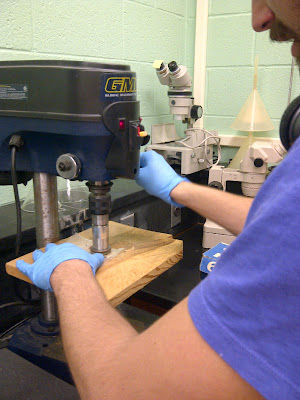Thousand Cankers Disease, or TCD is
a new, serious disease complex in the U.S. that affects certain walnut species
(Juglans spp.). This disease was identified and named in 2008 in
the Western U.S., but recently has been found in the Eastern U.S. TCD has
most recently been discovered in areas of Tennessee (August 2010), Pennsylvania
(June 2011), and Virginia (August 2011). Thousand Cankers Disease,
caused by the fungal pathogen, Geosmithia morbida, has been found to be associated with the only known insect
vector, the walnut twig beetle (WTB, Pityophthorus juglandis
Blackman). The infection and colonization of the fungus Geosmithia
morbida around walnut twig beetle galleries just beneath the bark causes
many dead pockets or cankers in the phloem, just as the name “Thousand Cankers”
states. The cankers begin decaying the wood at multiple walnut twig
beetle entry and exit points on branches larger than ¼ inch, and along
trunks. These cankers can kill the cambium and discolor the sapwood; thus
causing twig or branch girdling, and eventually tree death. Because Thousand
Cankers Disease has been associated with sudden walnut mortality in the United
States, this disease is considered an economic and environmental threat.
Therefore, public awareness, education, and effective regulations for
this disease are very important to prevent the spread of Thousand Cankers
Disease to other native walnut areas in the U.S.
University of Illinois Extension announced that a first-detector
training program focusing on tree pests will be offered at six
locations in Illinois in February and March 2013. These courses will
provide in-depth training on current and emerging pathogens and insects
affecting Illinois trees.
The target audience includes certified arborists, tree care professionals, master gardeners, master naturalists, forestry and natural resource professionals, conservationists, and others with an interest in trees. Continuing Education Units (CEUs) will be available.
The objectives of the training include the following:
- Improve first-detector training and invasive species awareness,
- Reduce potential risks from pathogens and pests,
- Increase rapid and affordable plant diagnostic support to local, state, and national agriculture and green industry programs and to end-users.
- Identification/detection,
- Life cycle/biology,
- Hosts,
- Sampling,
- Management,
- Commonly confused look-alikes,
- Regulation
- Springfield, U of I Extension conference room, Feb. 12, 9 a.m. to 3 p.m.
- Quad Cities, Deere-Wiman Carriage House, Feb. 26, 9 a.m. to 3 p.m.
- Mt. Vernon, U of I Extension conference room, March 7, 9 a.m. to 3 p.m.
- Collinsville, U of I Extension conference room, March 14, 9 a.m. to 3 p.m.
- Champaign, U of I Extension conference room, March 21, 9 a.m. to 3 p.m.
- Lemont, University of Illinois Extension, Midwest Golf House Complex, March 26, 9 a.m. to 3 p.m.
Each participant will receive a binder of EAB, TCD, and invasive plant information. A special feature will be key tree drawings (provided by Jean Burridge) to aid in identifying ash, walnut, or “look-alike” trees. Additional online training modules covering topics that will not be discussed during the one day program will be available to program participants prior to training.
All participants will receive a certificate stating that they are Illinois First Detectors.
This program is made possible by an Illinois IPM Grant and was developed by a special committee: Stephanie Porter, U of I plant clinic diagnostician and outreach coordinator, Kelly Estes, U of I agricultural pest survey coordinator, Travis Cleveland, U of I extension specialist in the Pesticide Safety Education Program (PSEP), Jay Hayek, U of I extension specialist in forestry, David Shiley, U of I extension educator, Andi Dierich, Morton Arboretum Forest Pest Outreach and Survey Project, Emily Hanson, Sothern Illinois University urban and community forester, and Jean Burridge, U of I Plant Clinic staff and certified arborist.


















